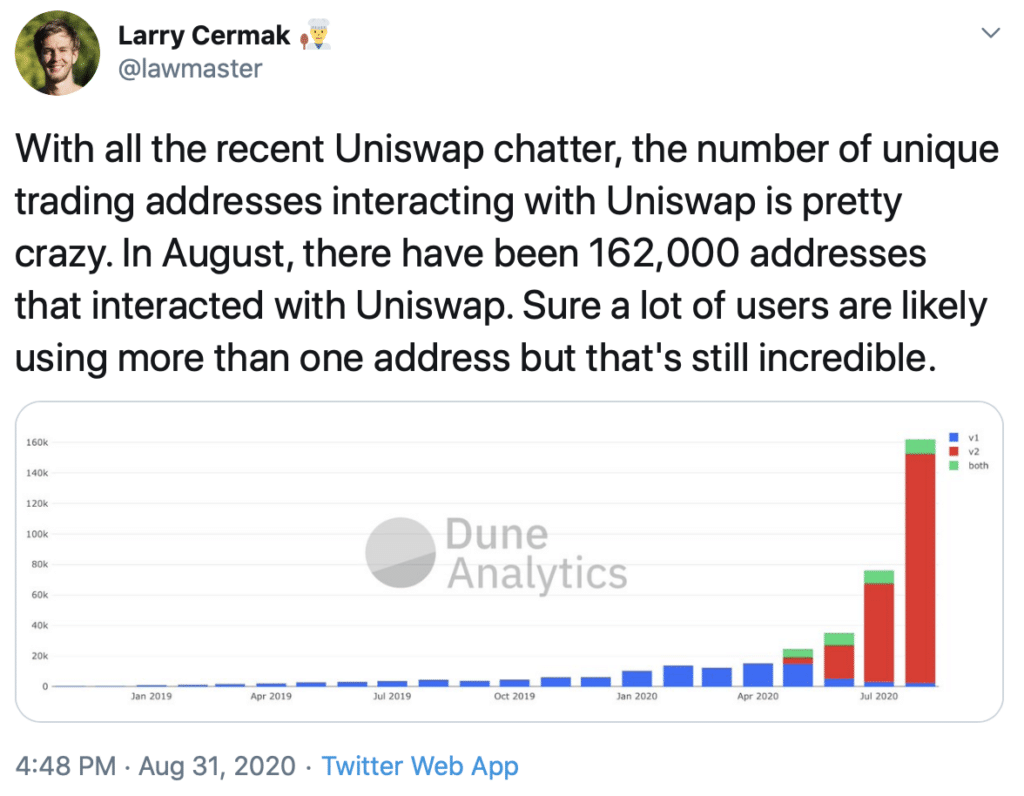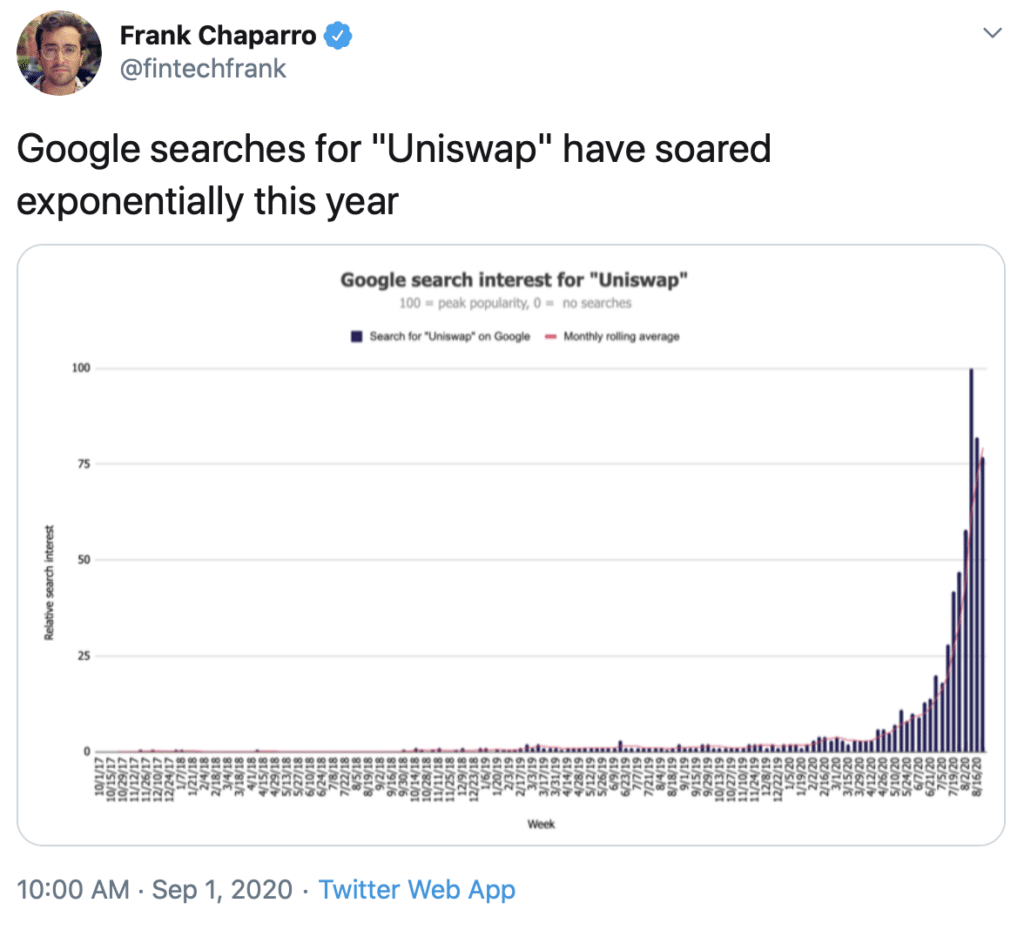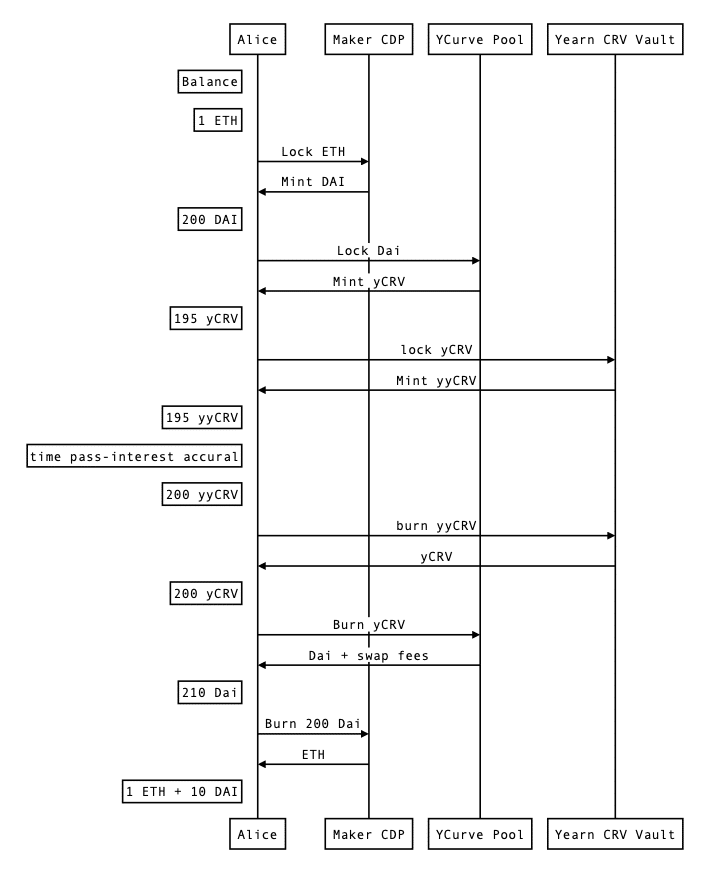(But with a lot of risk.)
It’s been a crazy week in crypto, or DeFi in particular, which is seeing a battle of forks between Uniswap and SushiSwap, and which saw its yield farming craze taken to new heights, with yETH, a kind of one-stop shop for yield farming. Where this is all headed is anyone’s guess — will SushiSwap win in the end as yield farmers chase yields? Or will Uniswap’s v3 turn the tide? Or, will SushiSwap simply fork v3 as well with a new twist on the yield? Plus, will Ethereum scale in time for DeFi demand? Since it doesn’t look like it, we’ll see where liquidity goes.
On Unchained, Haseeb Qureshi of Dragonfly Capital and Dan Robinson of Paradigm break down the rise in the class of dexes known as automated market makers — why has Uniswap been able to overtake Coinbase’s 24-hour volume? Why are people paying more in fees on Uniswap than on Bitcoin? On Unconfirmed, Nadav Hollander and I discuss the battle between SushiSwap and Uniswap. Read on to find out more of the DeFi craziness that happened this week, and where the fair launch trend is going.
This Week’s Crypto News…
DEX Volumes Hit New All-Time High as Uniswap Overtakes Coinbase
Decentralized exchanges saw $11.6 billion in trade volume in August, up from less than $1 billion in January. This sets a third consecutive monthly record in DEX volume, up from $4.5 billion in July. As Denis Vinokourov, head of research at Bequant, told CoinDesk, “It indicates that the DeFi flippening is real and already here.”
Uniswap is leading the charge in decentralized exchange growth, with a reported 283% increase in 24-hour trading volume from July to August, and more than $1 billion in trading volume on Tuesday and on Wednesday this week, which was roughly 50% higher than the 24-hour volume on Coinbase Pro at the time.
To illustrate just how massive the increase in trading on Uniswap has been, Larry Cermak of The Block posted a graph on Twitter showing the staggering increase in unique trading addresses on Uniswap alone in the last few months.

Frank Chaparro of The Block also posted a diagram showing the exponential growth in Google searches for Uniswap this year, which began shooting up in April but have quadrupled since July.

It’s not all unicorns and rainbows, however. While the surging volumes on decentralized exchanges present a challenge to established centralized exchanges like Coinbase, they’ve also increased fees on Ethereum due to congestion.
yEarn’s yETH Vault Makes It Easy to Yield Farm
yEarn.Finance has launched a vault for yield farming with ETH. As the recently departed chief of oracles at MakerDAO, Mariano Conti, explained to the Bankless podcast, put simply, this will make it easy for anyone who holds ETH to get involved with yield farming. Think Betterment, but for yield farming. Because yEarn utilizes the automated market maker Curve, stablecoin deposits won’t be required, as has been the case with previous yield farming projects.
Anthony Sassano, in his Daily Gwei newsletter, explained how the yETH vault works. After a user deposits his or her ETH, it is put in MakerDAO to borrow DAI, which is then deposited in CRV to withdraw its liquidity provider tokens and earn CRV tokens. The CRV is then recycled into ETH by buying more on the open market. Because yEarn uses smart contracts to find the best yield, gas costs for multiple operations are ostensibly spread across several users, saving on transaction fees.
On Tuesday’s Bankless, Conti referred to the vault as the smart contract equivalent of “set it and forget it,” because “you are earning a lot of money on your ETH without losing exposure to your ETH.” But, as the hosts of Bankless and Sassano, noted, this does not come without risks, as the creator of yEarn famously tests in production, which means putting your money in smart contracts whose level of security is unknown.
This image, which, if you have some background, is somewhat easy to follow, breaks it all down:

Gas Fees on Ethereum Reach All-Time High, Putting Focus on Scaling
With all this yield farming activity on Ethereum, it’s no wonder that, according to The Block Research, Ethereum miners generated record fee revenue of $17 million on September 1, which is almost four times higher than at the peak of the 2017-2018 frenzy.
However, Ethereum’s exorbitant fees highlight the limitations presented when it comes to scaling DeFi. On the 0x blog, Remco Bloemen argued that, at present, Ethereum has become a place for the rich, as only whales can profit from trading with such high transaction costs. However, he says, simply raising gas limits then creates risks for Ethereum’s security. He analyzes whether it’s possible to scale at layer one but concludes the only reliable solution, aside from focusing on layer 2, is “to tear everything down and rebuild it from the ground up.”
Vitalik Buterin posted a lengthy Twitter thread arguing against trying to solve the problem of high gas fees by artificially setting gas prices higher or lower, which he calls “naive.” He advocates for increasing transaction capacity through scaling, citing migration to ZK-Rollups by Tether, Gitcoin, and other apps as the best solution.
Has DeFi Reinvented the Fair Launch?
In case you haven’t noticed, everyone is excited now about fair launches. Many crypto projects have attracted criticism over distribution mechanisms that favored early adopters. Enter, the fair launch — a trend kicked off by yEARN’s $YFI, which launched without a pre-mine, founder equity, or venture capital.
At Deribit Insights Hasu analyzes the fair launch, looking at previous altcoin launches and noting that projects that on the surface look fair are not often so. He says investors should scrutinize any coin advertising a fair launch as a core feature to see if there are any possible exploits.
Ian Lee, the managing director of IDEO CoLab Ventures, wrote in his email newsletter, Synthesis, a post titled “Fair Launches Will Disrupt Crypto VC.” He says, “If fair launches become more common, sophisticated, and successful, they should scare the sh*t out of crypto VCs.” He believes they will become more fair and not advantage whales as much as current fair launches do, and reward people not just for short-term activity, but also for longer-term actions and other forms of participation such as voting and proposals. He also thinks that returns will not scale one-to-one with the amount of liquidity one has — again, in an attempt to keep whales from earning a disproportionate amount of rewards. In a subsequent post, he argues that fast-follower forks such as SushiSwap will become more common and that projects without a token have a higher risk of having their project forked, tokenized and fair launched. He also said that projects now will have to be careful to not take on too much venture capital.
The SEC is Keeping a Close Eye on DeFi
In an interview with The Block, Securities and Exchange Commissioner Hester Peirce, said the SEC is taking notice of DeFi and the questions it is posing, saying, “I think it’s going to challenge the way we regulate.” While Peirce admitted that DeFi regulation isn’t at the top of the SEC’s list of priorities, she concedes that the agency is following the space closely. Peirce, who is known as ‘Crypto Mom,’ has shown a keen interest in the cryptocurrency industry and stated that the delicate line between fostering innovation and protecting investors will become even more precarious with the rise of DeFi.
How Patoshi Mined Strategically to Protect the Bitcoin Network
Serigo Demian Lerner, the researcher who has looked into the early mining habits of a miner he believes was Bitcoin creator Satoshi Nakamoto, and who discussed his findings on a recent episode of Unconfirmed, has discovered that this miner used a mining algorithm not included in the release of the first Bitcoin client. Lerner, not being 100% sure of the identity of this miner, has nicknamed the miner Patoshi. Lerner recently re-mined Bitcoin’s first 18,000 blocks and discovered that Patoshi’s miner did not mine the way the early public software did. While the public software, which is ostensibly searching for a number that will enable it to mine the next block, would do one sweep for this number, Patoshi would do multiple sweeps. Additionally, Patoshi reduced the hashrate of his or her miner several times that first year, plus likely shut down his or her miner for five minutes every time Patoshi mined a new block so as to foster competition and create a diverse set of miners. On the other hand, Patoshi also would turn on his or her miner when there weren’t a lot of other computers on the network. Lerner says,“I conclude that the most plausible explanation is that he was protecting the network.”
How Dan Robinson Lost Someone’s Money to a Frontrunning Bot
This week’s Unchained guest, Dan Robinson of Paradigm, published a blog post about a conundrum he was posed with last week: Someone had accidentally sent their Uniswap liquidity tokens to the pair contract itself, where anyone could grab them, if they realized the tokens were there. The challenge for Dan was that, because of frontrunning bots that scour the mempool, or the area of pending transactions, once he submitted a transaction to rescue the funds, any frontrunning bot could see them, which as he put it, “would be like flashing a ‘free money’ sign pointing directly at this profitable opportunity.” He entails all the machinations he went through to try to obscure the transaction and stealthily secure his friend’s money. Read his post to find out what happened — and learn why you should never underestimate a frontrunning bot.



